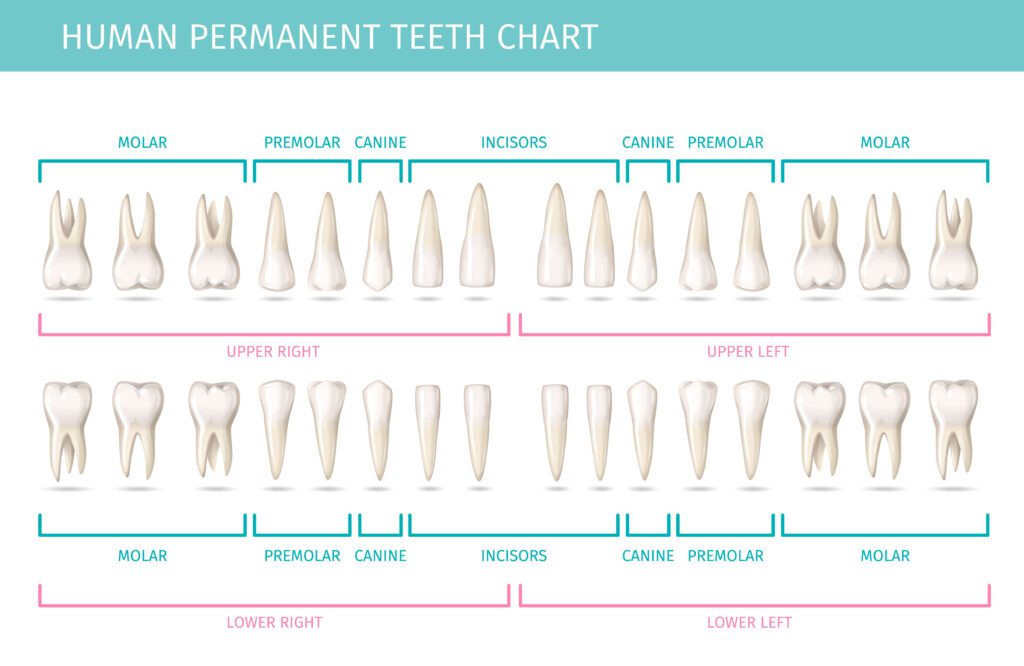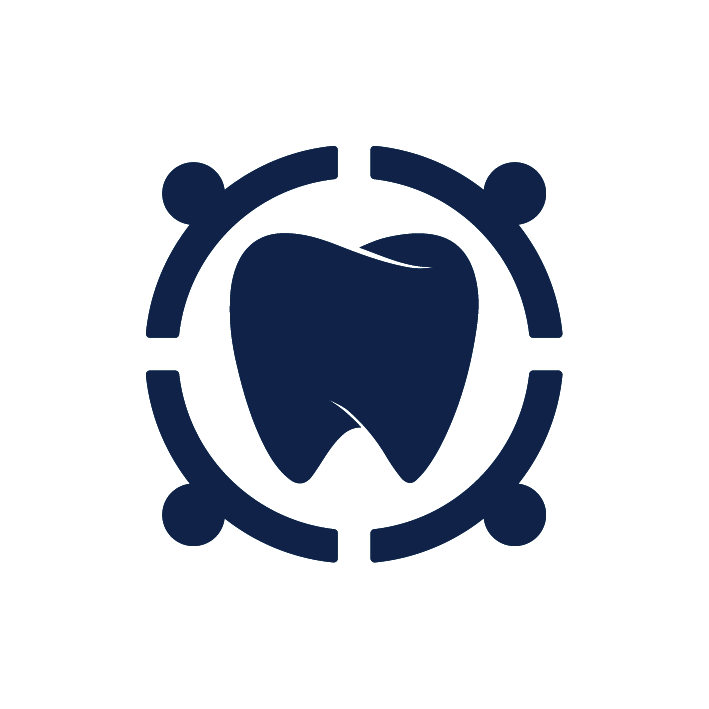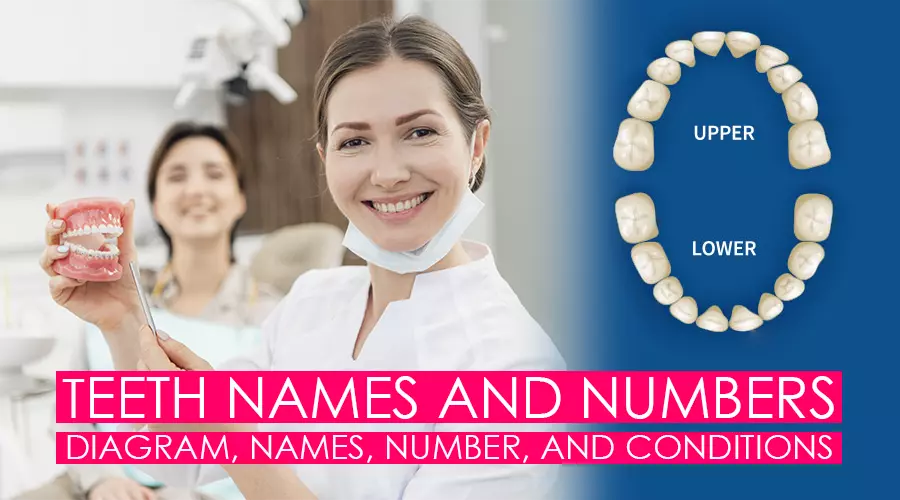An adult has 32 teeth, teeth names and number are given based on their arch, class, type, and side. On the other hand, children have 20 primary teeth and start to grow their first actual teeth by the age of 6.
There are two sets of teeth in human beings; the first are named primary or baby teeth and permanent or adult teeth. The collection of teeth that replaces primary teeth are called succedaneous or permanent dentition.
Current recommendations are to see a dentist as soon as the child turns a year old. A dentist can better explain teeth names and numbers so you can identify them. It is essential to see a dentist if your child does not start to get teeth within the year.
The first visit will get your child familiar with the dentist. Healthy development is vital to the appropriate development of the child’s nutrition and speech.
Teaching them helps develop lifelong oral health habits that will apply to adult teeth. For most parents, by the age of 7, the child will start to lose their baby teeth. They are making space for the child’s front teeth to come in.
There are four classes of teeth: Incisors, Canines, Premolars, and Wisdom Teeth.
Each tooth serves a unique function :
- Canines: The canine teeth are the quick teeth placed on either part of the incisor’s side. Canine teeth (also called cuspids) job combine with the incisors to bite and tear food.
- Lateral incisors: The four lateral incisors are next to the middle incisors on both arches, one on either side. These teeth have fast incisal edges used for tearing food.
- Central Incisors: The middle incisors are the face teeth. Adults have four middle incisors; 2 on the lower and two on the upper arches. These teeth are fast and shaped like a chisel for cutting food.
- Premolars: The premolars (also called bicuspids) and the eight teeth placed next to the cuspids. These teeth are smaller than the molars and have two cups on the biting location for crushing and tearing food.
- Molars: The molars are larger teeth with four cups placed in the mouth back behind the premolars. Adults have 12 molars, with 6 in the lower and 6 in the upper arches; 3 on each side of the mouth. Molars have flat, broad surfaces for chewing, biting, and grinding food.
- Wisdom teeth: which are among the molars are the final four molars that most adults develop. These teeth are the last to come in, 2 in the upper, and 2 in the lower arches. Wisdom teeth erupt during the teen years but can grow at any time. Not all wisdom teeth need extraction. Some need to be removed due to the danger of infection, overcrowding, or misalignment. Trust Dental Care will help you to make this planing for your oral health.

Teeth name position in the mouth makes it easier for the dentists to identify them for treatment.
Teeth Names and Numbers in Human Mouth
Teeth names in the human mouth are given according to their anatomic shape or letter or number.
Their names should be recognized fully to avoid confusion and to facilitate quality dental care (for example, right mandibular second molar). Given that there are four-second molars, naming the quadrant (right mandibular), which specifies the second molar, makes it easy to recognize.
The human teeth are arranged symmetrically in the mouth, and it is possible to know teeth names and teeth numbers.
Dentists have designated each tooth name with hence, teeth names in English. Cuspids are synonymous with canines, while bicuspids are also known as premolars.
The six-year molar is also called the first permanent molar. The twelve-year molar is used synonymously with the second permanent molar while the wisdom teeth (so-called because of their late eruption) are called third molars.
The teeth in the front of the mouth, such as incisors, lateral incisors, and canines, are called anterior teeth.
Posterior teeth comprise of teeth located in the back of the mouth, and they are known as premolars and molars. The mandibular is the name given to the teeth in the lower jaw, while the maxillary is the group name of the teeth in the upper jaw.
| Upper Right Quadrant | |
|---|---|
| Teeth Numbers | Teeth Names |
| 8 | Incisor (Central) |
| 7 | Incisor (Lateral) |
| 6 | Canine (Eye tooth / Cuspid) |
| 5 | Bicuspid (1st) |
| 4 | Bicuspid (2nd) |
| 3 | Molar (1st Molar) |
| 2 | Molar (2nd Molar) |
| 1 | Wisdom Tooth (3rd Molar) |
| Lower Right Quadrant | |
|---|---|
| Teeth Numbers | Teeth Names |
| 32 | Wisdom Tooth (3rd Molar) |
| 31 | Molar (2nd Molar) |
| 30 | Molar (1st Molar) |
| 29 | Bicuspid (2nd) |
| 28 | Bicuspid (1st) |
| 27 | Canine (Eye tooth / Cuspid) |
| 26 | Incisor (Lateral) |
| 25 | Incisor (Central) |
| Upper Left Quadrant | |
|---|---|
| Teeth Numbers | Teeth Names |
| 9 | Incisor (Central) |
| 10 | Incisor (Lateral) |
| 11 | Canine (Eye tooth / Cuspid) |
| 12 | Bicuspid (1st) |
| 13 | Bicuspid (2nd) |
| 14 | Molar (1st Molar) |
| 15 | Molar (2nd Molar) |
| 16 | Wisdom Tooth (3rd Molar) |
| Lower Left Quadrant | |
|---|---|
| Teeth Numbers | Teeth Names |
| 17 | Wisdom Tooth (3rd Molar) |
| 18 | Molar (2nd Molar) |
| 19 | Molar (1st Molar) |
| 20 | Bicuspid (2nd) |
| 21 | Bicuspid (1st) |
| 22 | Canine (Eye tooth / Cuspid) |
| 23 | Incisor (Lateral) |
| 24 | Incisor (Central) |
Teeth Names and Numbers Diagram
Teeth names and position in the mouth makes it easier for the dentists to identify them for treatment. The shapes of the teeth help in positioning them.
Teeth are given names by the positions they occupy in the mouth. Each of these teeth numbers is either positioned in the lower jaw or upper jaw.
Those who are in the lower jaw are known as mandibular, and those in the upper jaw are identified as maxillary.
Also, the side of the face (i.e., right or left) the teeth are positioned determines their names. The maxillary incisor is positioned distally from both maxillary central incisors of the mouth and mesially from both maxillary canines.
The mandibular central incisor is situated in the jaw adjacent to the midline of the face. The mandibular lateral incisor is placed distally from both mandibular central incisor and mesially from a mandibular canine.
The maxillary and mandibular canines are positioned three teeth from the midline, and they separate the premolar from the incisors.
Teeth Names and Their Functions
Human teeth’ names are associated with their functions. The teeth are categorized into four; they have a typical appearance and perform specific options.
They perform these functions according to their shapes and morphology.
The human species are omnivorous because they eat both plants and meat. This particular characteristic demands two specific types of teeth, namely, incisors also referred to as cutting teeth, which are used to cut foods into smaller pieces to facilitate inward movement into the mouth.
Of this type are also canines which are also known as eye teeth or cuspids, they have sharp and pointed edges which are used for chewing and grinding, they can even pierce and rip at the side of the cusps.
The most important function is that they start grinding the foods before transferring them to the molars for final grinding and swallowing.
The work of the dentist is made simpler because of the teeth names which are associated with their functions.
There are different kinds of actual teeth, each of which performs a unique function:
- Canines: The canine teeth are the quick teeth placed on either part of the incisor’s side. Canine teeth (also called cuspids) job combine with the incisors to bite and tear food.
- Lateral incisors: The four lateral incisors are placed next to the middle incisors on both arches, one on either side. These teeth have fast incisal edges used for tearing food.
- Central Incisors: The middle incisors are the face teeth. Adults have four middle incisors; 2 on the lower and two on the upper arches. These teeth are fast and shaped like a chisel for cutting food.
- Premolars: The premolars (also called bicuspids) and the eight teeth placed next to the cuspids; 2on each side of the mouth, four on the lower arches, and four on the upper arches. These teeth are little than the molars and have two cups on the biting location for crushing and tearing food. The premolars nearest to the incisors are known as the first premolars, while the ones nearest to the molars are known as the 2nd premolars.
- Molars: Molars are the big teeth with four cups placed in the mouth back behind the premolars. Adults have 12 molars, with 6 in the lower and 6 in the upper arches; 3 on each side of the mouth. Molars have flat, broad surfaces for chewing, biting, and grinding food.
- Wisdom teeth: which are added among the molars are the final four molars that most adults grow. These teeth are placed in the extreme back of the mouth, 2 in the upper, and 2 in the lower arches. Wisdom teeth erupt during the teen years but can grow at any time. Not all wisdom teeth need extraction. Anyway, due to the danger of infection, overcrowding, or misalignment, your dentist may plan that your wisdom teeth should be deleted.
The list of teeth names, their functions, and their development are as follows:
- Incisors. Incisors are a Person with eight front teeth, with four on top and four on the bottom. The 2 in the center are the middle incisors, while the two on either side of the central teeth are known as lateral incisors. The significant function is to bite food. Babies grow their incisors at approximately six months old. After the first incisors fall out between ages 6 and 8, the actual incisors emerge.
- Canines. Canines are fast teeth placed outside the incisors. Adults and children have four canines, two on the top and two on the bottom, to tear their food. Canine’s primary appears when a kid is approximately 16 to 20 months old. The actual lower canines come in at around ten years old, and top canines erupt between 11 and 13 years old.
- Premolars. Premolars, also knew as bicuspids can tear and chew food. They are somewhat flat with ridges on the peak, and there are four on each side—the premolars developed by approximately 10 to 11 years of age.
- Molars. Molars also grind and chew food, they work better to grind food than the premolars, and the job with the tongue to swallow food. These 12 teeth are placed in the mouth back, and they start to appear in kids at approximately 12 to 15 months old.
Primary Teeth vs. Permanent Teeth: Unraveling Dental Evolution
The dental journey begins in childhood, where primary teeth, also known as baby teeth, make their appearance. These 20 temporary teeth pave the way for the development of permanent dentition. As children grow, they gradually lose their primary teeth, making space for the eruption of adult teeth. This transition, facilitated by the body’s natural growth, is a crucial phase that impacts proper nutrition, speech development, and overall oral health.
Then the actual molars come in, first at about six years old, and the second molars rise in children between 11 and 12 years old.
Then the actual molars come in, first at approximately six years old, and the second molars rise in children between 11 and 12 years old.
The 5th type of tooth is the 3rd molar also referred to as wisdom tooth.
People grow 3rd molars at approximately age 18 or 25 if they grow them at all.
Many people have them removed if they cause overcrowding or pain in the mouth. In case you need a tooth extracted, consult a dentist.
It is paramount to keep your teeth clean with fluoride toothpaste at least two times a day. It is especially vital to clean before you go to bed.
The top way to brush is to move in small circles, go around until you have covered every side of every tooth.
You should clean the space between teeth by flossing once a day. It removes plaque and food that get stuck between them.
To maintain optimal health, you need to see your, dentist, every six months to prevent long-term diseases. We hope you learned about teeth numbers and teeth names.
Frequently Asked Questions
What are teeth numbers and names?
Teeth numbers and names refer to the systematic identification and classification of teeth based on their position, function, and anatomy.
How are teeth numbered and named?
Teeth are numbered and named according to their quadrant, arch, and anatomic position. This system ensures precise communication in dental discussions.
Why do dentists use numbers when checking teeth?
Dentists use numbers to accurately identify and communicate about specific teeth during examinations, diagnoses, and treatment planning.
What tooth numbers are wisdom teeth?
Wisdom teeth are numbered 1 and 32, representing the third molars located in the upper and lower arches.
Is each tooth connected to an organ?
Traditional Chinese medicine associates teeth with various organs and systems, but this connection is not recognized in conventional dentistry.
Should I have 28 or 32 teeth?
Adults typically have 32 teeth, including wisdom teeth. However, some individuals may have fewer due to extractions or congenital absence.
What are the benefits of keeping your wisdom teeth?
Keeping wisdom teeth can be beneficial if they are healthy, well-positioned, and functional. However, removal may be necessary to prevent complications.
If you have any questions, contact us or call us at (844) 848 7878, we are here to help you!




Leave a Reply